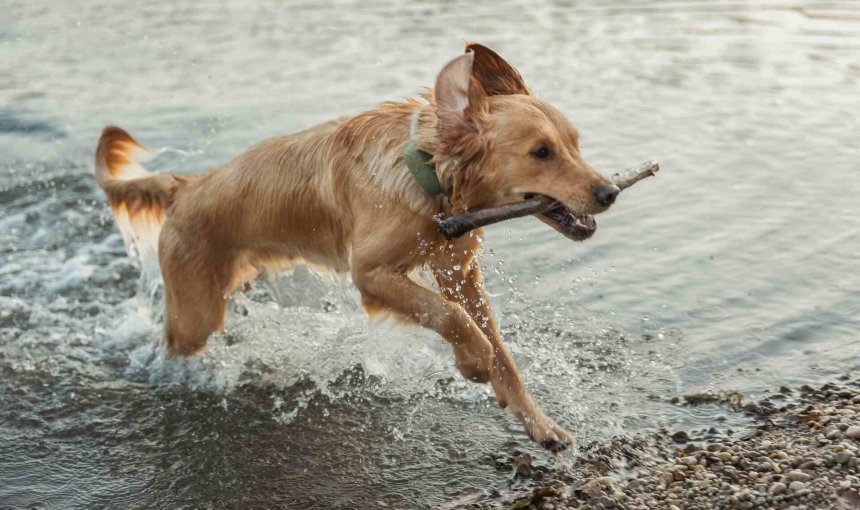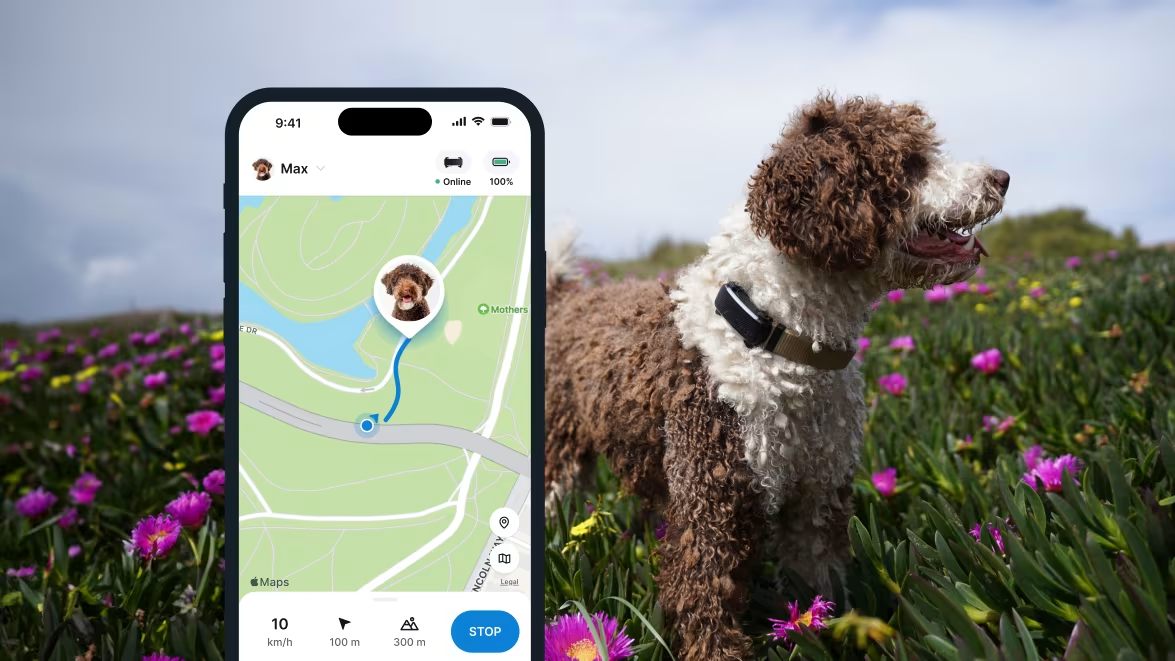 Approved by Dr. Dwight Alleyne, DVM
Approved by Dr. Dwight Alleyne, DVM How To Calm A Dog Down (When They’re Getting Hyper!)
Many dogs tend to be hyperactive - whether it's due to excitement, boredom, happiness...or even anxiety. Which, with time, can get pretty exhausting for all pet parents. So here are 6 steps you can take to help your buddy calm down.

If your buddy is leaving you exhausted every day, you’ve gotta wonder, how to calm a dog down when they’re getting hyper? In this post, we’re going to cover the reasons your doing might suddenly be having these fits and bursts of energy – and what you can do to help them chill out a bit more. (Like using a smart dog tracker with Bark Monitoring in case it’s because of anxiety.)
Key Takeaways
Hyperactivity has many causes
A dog’s hyperactivity can be due to its breed or age, lack of exercise, or excitement. It could also be because of more serious issues like anxiety, a poor diet, or a health problem.
Keeping your dog calm needs a long-term plan
For immediate relief, you can use calming sounds or speak in a calm voice. For a long-term solution, establish a consistent routine, provide a safe space, ensure regular exercise, and keep your dog mentally active.
A vet can help with serious cases
For more severe cases, like anxiety, a veterinarian may be able to prescribe medication or other treatments.
Use a smart dog tracker
Your Tractive device comes with real-time GPS tracking for hyperactive dogs who may be prone to running away. It also comes with Bark and Separation Anxiety monitoring to help you better understand your dog’s behavior.

Always know your buddy is healthy & safe
Read moreWhy is my dog so hyper?
If your dog is constantly bursting with energy, it can be both fun and exhausting. While some level of hyperactivity is normal, especially in puppies or high-energy breeds, it’s important to understand the underlying causes of your dog’s hyper behavior. Here are some common reasons why your dog might be so hyper, along with some more concerning possibilities.
Common causes of hyperactivity in dogs
- Breed and age
Some dog breeds, like Border Collies, Jack Russell Terriers, and Labrador Retrievers, are naturally more energetic. Puppies and young dogs, in particular, tend to have more energy as they grow and explore their world. - Lack of exercise
If dogs don’t get enough playtime, walks, or interactive activities, they can become overly energetic, leading to hyperactive behavior around the house. - Excitement or playfulness
Dogs get excited just like people do! If you’ve been away for a while, your dog might be hyper simply because they’re happy to see you. Playful behavior can also lead to bursts of energy, especially if they’re anticipating fun or attention. - A change in routine
Moving to a new home, meeting new people, or introducing new pets can make some dogs feel hyper as they adjust to their new surroundings.
More concerning causes of hyperactivity in dogs
If you’ve ruled out the common causes and your dog’s hyperactivity persists, or if you notice signs of distress like excessive panting, drooling, or pacing, it’s a good idea to consult your vet. Your dog’s hyperactivity might be because of:
- Anxiety or stress
Dogs that experience anxiety, whether from separation anxiety, fear of certain noises, or past trauma, can exhibit hyperactive behavior. This might include excessive pacing, barking, or agitation that’s more than just excitement. - Health issues
Certain medical conditions, such as thyroid imbalances, can cause hyperactivity in dogs. If your dog is acting more hyper than usual without an obvious cause, it could be a sign of an underlying health issue that requires a vet’s attention. - Diet or nutrition
A poor diet or food that contains high levels of sugar or artificial additives can lead to bursts of energy. Overfeeding or feeding at irregular times might also contribute to hyperactive behavior. - Hormonal changes
Unspayed females or unneutered males may experience hyperactivity because of hormonal fluctuations. In some cases, these changes can make them more excitable or prone to erratic behavior.
💡A smart dog tracker with real-time GPS tracking can be an important emergency measure. (Especially if you’ve got a hyper dog who tends to run away at the slightest sight, smell, or sound.) With one strapped to your dog’s collar, you can track their movements in real-time and intercept them before they head off too far.

Follow your dog anywhere
Get real-time location information, wherever they go. And find out when they try to make an escape, or just when they go somewhere they shouldn’t, with Virtual Fences.
How to calm a dog down instantly
When your dog is in a hyper state or overly excited, it can be challenging to get them to relax. However, there are a few quick steps you can take to help calm them down instantly:
- Distract your dog
Try offering a favorite toy or treat to divert their attention. Sometimes, focusing on something else can help shift their energy away from hyperactivity. - Use calming sounds
Play soothing music or calming sounds specifically designed for pets. This can help create a peaceful environment and reduce excitement. - Speak in a calm, steady voice
Dogs often mirror our emotions, so speaking gently and confidently can help your dog feel more at ease. Take a few deep breaths to help your dog mirror the motion. - Physical touch
Gently petting or massaging your dog can help lower their stress levels and promote relaxation. - Use a calming aid
Some dogs benefit from calming sprays or treats with ingredients like lavender or chamomile. Make sure to consult your vet for recommendations.
How to calm down a hyper dog – over the long-term
Now in some serious cases, like if your dog has anxiety or symptoms similar to ADHS, you’re best off discussing your concerns with your vet. They may prescribe you specific anxiety medication, supplements, or even spaying or neutering as an option. But before you head to your clinic, here are some steps you can take to help your dog burn off their extra energy that much better.
Help your dog get back to a consistent routine
Much like us, a big change in routine can majorly stress out your dog – which may turn up as hyperactive behaviors. But not all dogs’ anxiety or stress manifests as hyperactivity. (Some might withdraw or seem depressed.) But in both cases, it can help to take little steps to help them develop a consistent routine. Including regular:
- Mealtimes
- Play time
- Sleep time
- Quality time together
All of which can help your dog feel calmer, more settled, and less likely to have all that extra energy.
Set up a “safe space” for your dog
Whether you’re at home or not, an enriched, “safe space” for your dog can work wonders in helping them calm down. One that ideally includes:
- A ton of toys and treats
- “Tricky” toys (like food puzzles) to keep them occupied
- A designated sleep area, like their crate or bed
- Some relaxing music or white noise, to help create a soothing environment
- A special blanket or even one of your sweaters (or even a pair of socks!) – something with your scent to help them feel reassured
Make regular exercise a priority
Doesn’t matter how much of a couch potato you both are – there’s no substitute for regular exercise, both physical and mental, for your dog. With regular walks and playtime, you both keep your dog healthy, help them burn off their extra energy, and also help them feel more secure with a routine. (Win-win all the way, if you ask us.) Else, for a challenge, take them out running, hiking, biking, or even camping with you!
Keep your dog mentally active
Besides regular exercise, another way to help your dog calm down is keeping them mentally active. (The brain is a muscle after all and needs its own workout!) So they’re less likely to get up to mischief out of boredom or anxiety, if you invest in:
- Puzzle toys to help them stay active and engaged (especially if you aren’t home)
- Food dispensers that make your dog have to “work” for getting a treat (by, say, solving a puzzle)
- Giving your dog a “job” – like, say, babysitting your kids or cleaning up their toys. This can help redirect their energy towards a productive activity and prevent them from getting bored or restless.
- Regular training, especially for the most basic obedience commands. Take it slow and repeat commands like “Sit”, “Stay”, and “Come” as much as you can.
- Revisiting your dog’s training can help refresh their memories and ensure they’ll do as you say when you’re both outdoors.
- Try new methods of training, like, for example, with a clicker to help keep both you and your dog engaged. Clicker training for dogs is a tried and trusted method of positively reinforcing “good” behaviors.
Enroll your dog in an obedience class
If your dog is just way too energetic to handle – or you just can’t make time – leave some jobs to the pros by enrolling them in an obedience training class. This can help your dog get used to hanging out with other pets and people, learn the basic rules of dog “etiquette”, and pick up some training commands – from the experts themselves.
⚠️ Because in an emergency – like if your dog’s gone running off after a woodland critter on a hike together – being able to override their instincts with proper training (especially for recall) might just save their life.
Read more: Dog Recall: How To Teach Your Dog To Come When Called
Plan ahead for a runaway dog
When your dog starts getting hyper, it can be difficult to keep up. (Especially if they’re prone to running off or bolting unexpectedly.) That’s why planning ahead is crucial for your peace of mind. With a smart dog tracker like Tractive, you can instantly know your dog’s location in case they slip away during a hyper moment.

Strapped to your buddy’s collar, your trusty Tractive device comes with:
- Real-Time GPS Tracking
Which allows you to instantly locate your dog if they run off. Giving you the peace of mind knowing you can always find them – with just a glance at your phone. - Bark detection
Which notifies you if your dog is barking excessively. Which could be a sign that they’re stressed or getting too wound up. - Separation Anxiety monitoring
Which tracks your dog’s behavior when you’re not around. Helping you identify early signs of anxiety that could lead to hyperactivity or destructive behavior. - Activity Monitoring
Which keeps track of your dog’s daily activity levels, helping you manage their energy and prevent overexcitement.
All this in one device – built with love for dogs and for your peace of mind as a dog parent.
Your furry friend’s health and wellbeing means as much as to us as it does to you. So we’ve made it a priority to only share medically-relevant content on our blog. This post was checked, double-checked, and medically verified by Georgia-based vet, Dr. Dwight Alleyne.

Dr. Dwight Alleyne, DVM
Originally from Long Island, New York, Dr. Alleyne began his career at a no-kill animal shelter before becoming a licensed veterinary technician. He graduated from Cornell University Veterinary College in 2006 and completed an internship at Purdue University. Now practicing in Georgia, Dr. Alleyne specializes in soft tissue surgery and ultrasounds. He also writes pet health articles on his website, “The Animal Doctor Blog” (www.anmldrblog.com).



